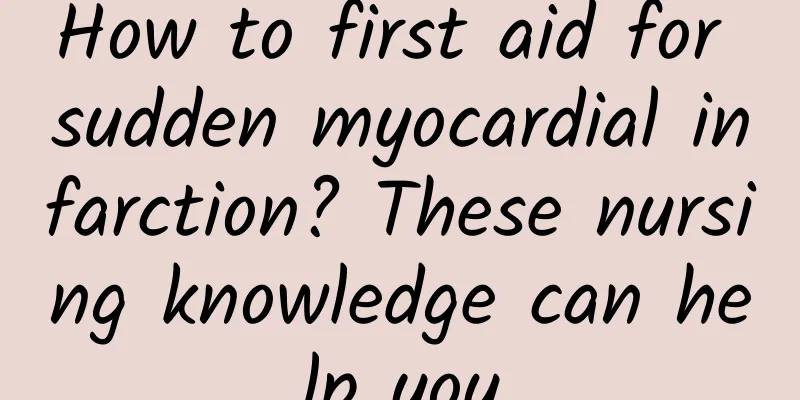How to first aid for sudden myocardial infarction? These nursing knowledge can help you

|
Author: Huang Lihong Unit: Community Health Service Center of Shuikou Subdistrict Office, Huicheng District, Huizhou City Myocardial infarction often occurs suddenly and progresses rapidly. It is extremely dangerous and catches people off guard. Many patients lose their lives because they fail to take effective measures to deal with it in time. In this critical moment of life and death, correct first aid measures can not only save lives, but also reduce the patient's subsequent complications. However, for ordinary people who are not medical professionals, they often feel helpless in the face of sudden myocardial infarction, which is mainly due to the lack of professional first aid knowledge. Today, let's talk about this topic and teach you the first aid care knowledge of sudden myocardial infarction. 1.What is myocardial infarction? Myocardial infarction is a serious heart disease, usually caused by the formation of blood clots in the coronary arteries, which block blood flow and lead to insufficient blood supply to some areas of the heart, causing myocardial tissue damage or necrosis. In our body, the coronary artery plays a big role in transporting oxygen and nutrients to the heart. If this process is blocked, it will cause serious consequences. Combined with our clinical practice experience, most patients with sudden myocardial infarction already have coronary atherosclerosis. The serious consequences of myocardial infarction include heart failure, sudden death and even death, which need to be taken seriously.
2. How to identify sudden myocardial infarction? The symptoms of myocardial infarction are very similar to those of another disease, angina pectoris. In clinical diagnosis and treatment, it is often necessary to distinguish between these two diseases. For medical staff, their medical knowledge is relatively rich and solid, and they can correctly distinguish. But for ordinary people who are not medical professionals, how to distinguish? In fact, although both angina pectoris and myocardial infarction have chest pain symptoms, the pain site of sudden myocardial infarction is relatively special, generally behind the sternum and the left anterior chest, and radiates to the pharynx, neck and back. The pain will last for a relatively long time, generally at least 15 minutes, and up to 2 days. However, angina pectoris is obviously different. The pain site of angina pectoris is concentrated in the precordial area and behind the sternum. The pain will be relieved in three to five minutes, usually not more than 20 minutes, and this pain is relatively concentrated, without radiating pain. Therefore, when identifying, patients should focus on perceiving their own pain site and recording the duration of the pain. If there is long-term pain, it is best to call 120 emergency number immediately.
3. How to provide first aid for sudden myocardial infarction? 3.1 Make a phone call for help The most important thing for ordinary people after a sudden myocardial infarction is to call the emergency number for help immediately. Based on clinical practice experience, we have found that implementing emergency measures within 120 minutes after a sudden myocardial infarction can greatly reduce the patient's disability and mortality rates. If a patient finds that he may have a sudden myocardial infarction, he should call the emergency number immediately after clarifying his symptoms and duration, inform the doctor of his situation, and clearly inform his home address, contact information and other information. If the patient is conscious, he can unlock the door after making the call to avoid being unable to get up and open the door for the emergency personnel later. If there are other relatives at home, they should also inform them of their condition immediately.
3.2 Avoid frequent activities Many people feel that they are conscious and have no obstacles in their movements after a sudden heart attack. While waiting for the arrival of emergency personnel, they start to be "diligent" and walk back and forth at home to pack clothes for subsequent hospitalization. Did you know? This is a very dangerous behavior. As we have said before, patients with myocardial infarction are very likely to have blood clots in their coronary arteries. Frequent walking at this time will not only increase the burden on the heart, but may also cause blood clots to fall off due to activities. Therefore, while waiting, patients should adjust their emotions, calm themselves down, and then take a semi-recumbent or supine position to rest. If there are other relatives at home, you can ask them to pack the luggage and don't move around casually. When changing from standing or sitting to semi-recumbent or lying position, be sure to move slowly and avoid drastically changing your body posture. Patients can ask their family members to help get a pillow and raise their feet.
3.3 Avoid carrying patients to the hospital by yourself After a sudden myocardial infarction, many patients worry that the emergency personnel will not arrive in time, so they want to go to the hospital by themselves, or let their family members carry them to the hospital. This practice is also wrong. The principle is the same as mentioned above. Whether it is carrying the patient or taking the patient to the hospital, it is very dangerous and is very likely to cause blood clots to fall off. Therefore, patients and their families only need to wait quietly at home for the arrival of emergency personnel, and keep in touch with the emergency personnel in time. If the patient has any unexpected situation, they can take effective measures to deal with it under the telephone guidance of the emergency personnel. 3.4 Increase oxygen support if conditions permit At present, with the development of the medical equipment industry, many pharmacies on the market are selling home oxygen concentrators, which are cheap and convenient to produce oxygen. If a patient suddenly suffers a myocardial infarction, family members can use the oxygen concentrator to supply oxygen to the patient until emergency personnel arrive. If there is no oxygen concentrator at home, you can also open the doors and windows to increase ventilation.
3.5 Correct use of emergency medicine When we call the emergency number, the emergency personnel will usually ask about the drug reserves at home. Therefore, having emergency drugs on hand is also a life-saving measure in case of sudden myocardial infarction. However, emergency drugs cannot be taken casually, and many drugs have contraindications. Therefore, whether it is family members or patients, before taking emergency drugs, they must communicate with the emergency personnel and take the drugs correctly under their guidance. At present, there are three types of emergency drugs commonly used for sudden myocardial infarction, namely nitroglycerin, quick-acting heart-saving pills and aspirin. Nitroglycerin has the effect of promoting coronary artery dilation. If the patient has myocardial ischemia problems, it can be significantly improved after taking it. However, glaucoma, drinking, low heart rate, low blood pressure, etc. are all contraindications to nitroglycerin, and blindly taking them may lead to serious consequences. Therefore, family members should accurately describe the patient's symptoms to the emergency personnel so that they can make correct judgments. Under the guidance of emergency personnel, patients can take 0.5 mg of nitroglycerin sublingually. This drug takes effect quickly, usually with obvious effects after 1-2 minutes. The contraindications of quick-acting heart-saving pills include low blood pressure and low heart rate. If there are no contraindications, 15 pills can be taken sublingually. Aspirin is a commonly used thrombolytic drug, but it also has many contraindications, such as hypertension, hemophilia, pregnancy, etc. If there are no contraindications, take 300 mg of the drug and chew it. Family members should also note that the premise of taking the medicine is that the patient is conscious. If the patient has fallen into a coma, then no medicine can be taken at this time. Just observe the patient's symptoms and wait for the arrival of medical staff. 3.6 Cooperate with first aid We often see this situation in clinical practice: when emergency personnel arrive at the patient's home, they find a large group of people around the patient. This will not only interfere with the implementation of emergency measures, but also cause poor air circulation and aggravate the problem of hypoxia. Therefore, the patient's family members should actively cooperate with the emergency personnel's treatment. After the emergency personnel arrive, they should immediately create a good environment for their first aid. What the family members need to do is to unconditionally trust and support the emergency personnel. Through the explanation of this article, I believe you have a certain understanding of the emergency measures for sudden myocardial infarction. Early identification and emergency treatment of myocardial infarction are very important, and we should all pay attention to it. |
<<: Spring walking peak, how to lose weight scientifically
Recommend
Can I eat crabs during menstruation?
I believe that there are always a few days every ...
How to regulate high testosterone levels in girls
If the estrogen level in the female body is too h...
What to do if you have itching below during confinement
For new mothers who have just given birth, confin...
How long after giving birth does hair loss start?
It is normal for women to lose hair after childbi...
Postpartum weight loss sharing
The greatness of a mother lies in the fact that h...
What to do if a woman has neurasthenia
Women's neurasthenia can cause dizziness and ...
What are the precautions after vaginal ultrasound?
It is best not to have sexual intercourse before ...
What are the symptoms of cesarean section sequelae
In daily life, many pregnant women choose to give...
Diet after uterine fibroid surgery
Uterine fibroids are a common disease among women...
Leucorrhea is like tofu dregs
Women's normal leucorrhea is transparent and ...
What is the reason for bloody menstruation?
I believe everyone must know the importance of me...
What causes slow development of gestational sac?
For every family, conceiving a child is a very im...
One month weight loss plan for girls
In fact, every person who wants to lose weight sh...
How to treat cervical hypertrophy
If female friends suffer from chronic cervicitis,...









